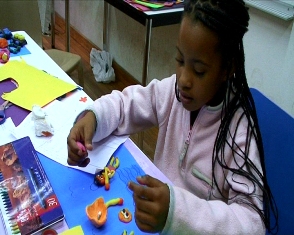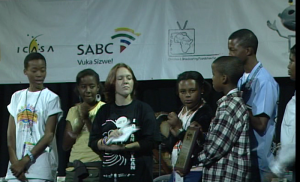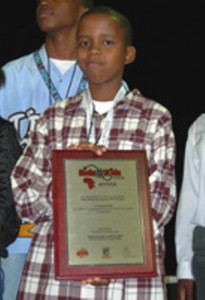By Dorcas Wambui Wanjau
Published September 13, 2014
 Although the mass media are the main socialising agent in the 21st century, it is not common to come across mass media that are specifically made for children.
Although the mass media are the main socialising agent in the 21st century, it is not common to come across mass media that are specifically made for children.
It was with the aim of helping produce high quality audiovisual media content for children and youth that an organisation calling itself the International Centre of Films for Children and Young People (Centre International du Film pour l’enfance et la Jeunesse, CIFEJ) was founded under the auspices of the United Nations Educational, Scientific and Cultural Organization (UNESCO) in the Scottish town of Edinburgh in 1955.
RELATED: Nairobi to Recognise Youth Creativity in Painting and Videography with Cash Prizes
CIFEJ: A History, a book published in 2005, details how the organization began, the challenges it has faced over the past 50 years and how it looks forward to the future even as social media take over our lives.
 “What will define our organization in the years to come is not our impressive past, but our capacity to articulate our future through pertinent actions, significant partnerships, and ground-breaking projects,” writes the then CIFEJ President, Athina Rikaki, in the Preface of the book. “This network is our stronghold, a unique environment where cultural diversity and access to quality audiovisual media for children is the base of our work.”
“What will define our organization in the years to come is not our impressive past, but our capacity to articulate our future through pertinent actions, significant partnerships, and ground-breaking projects,” writes the then CIFEJ President, Athina Rikaki, in the Preface of the book. “This network is our stronghold, a unique environment where cultural diversity and access to quality audiovisual media for children is the base of our work.”
Saying the “book teaches us to be truthful, honest and daringâ€, Rikaki says CIFEJ has “managed to survive through extremely difficult political situations, managed to reunite valuable, even though different people, managed to put forward a common goal for the greater good of children everywhere.”
RELATED: UK Literature Charity Creates Children’s Book Corners in East Africa
But apparently not all is well in Africa where the only film festivals for children are on the verge of death or have already breathed their last. While Egypt’s Cairo Children’s Film Festival wound up in 2012, Kenya’s Lola Kenya Screen can hardly be said to be blossoming despite the important work it does.

The book, written by Robert Roy, a former Secretary General of CIFEJ, says the organization that was first based in Brussels before it relocated to Paris, Montreal and then Tehran, received its financial support from UNESCO till the close of 1970 when it replaced its yearly allowance with support to specific programmes like studies in screen education, regional seminars on co-operation of youth and means of communication from 1971.
RELATED: Nairobi to Offer Short Courses in Television and Film Production
 CIFEJ moved to Canada in 1990 so as to obtain financial support from the Canadian Ministry of Communications. Its offices are currently in Iran where it is supported by the Institute for Intellectual Development of Children and Young Adults (KANOON) who edited and printed CIFEJ: A History that was used to commemorate 50 Years of CIFEJ and the CIFEJ General Assembly in 2005.
CIFEJ moved to Canada in 1990 so as to obtain financial support from the Canadian Ministry of Communications. Its offices are currently in Iran where it is supported by the Institute for Intellectual Development of Children and Young Adults (KANOON) who edited and printed CIFEJ: A History that was used to commemorate 50 Years of CIFEJ and the CIFEJ General Assembly in 2005.
Under CIFEJ, an initiative known as Kids For Kids Festival (KFKF) was mooted. Targeting children aged 6-12 and 13-16 years, it encouraged children to make films for themselves which were then entered for competition during a KFKF. Africa’s first KFKF Africa (KFKF-A), organised by CIFEJ and the Danish Film Institute with an international children’s jury, was held in Johannesburg during the 5th World Summit on Media for Children at which Lola Kenya Screen’s production, ilms by Children for Children, won the Grand Prize for its ‘achievement in the production of films by children for children.’ From then henceforth KFKF-Africa was held under the umbrella of Lola Kenya Screen in Nairobi, Kenya.
RELATED: Kampala Screens Films on Strong-Willed Children
 Taking a look at Africa in terms of children’s media, though, a lot is yet to be done. How many organisations take interest in media for children? How many or even production companies create content for children? How many broadcasting stations air content for children?
Taking a look at Africa in terms of children’s media, though, a lot is yet to be done. How many organisations take interest in media for children? How many or even production companies create content for children? How many broadcasting stations air content for children?
As he winds up, writer Robert Roy appeals to governments to offer grants to producers of children’s cinema. But as already illustrated by the demise of Cairo International Children’s Film Festival and the struggles of Lola Kenya Screen, Roy’s voice isn’t being heard.
RELATED: Children given special attention at SUBIOS, Seychelles Festival of the Sea 2012
It is great to have the history of CIFEJ in book form. However, one feels that this book would have been better written and edited. It reads more like disjointed company reports, complete with the statutes of incorporation. It also carries pictures—both black and white and colour and almost all of them small, blurred and not so well arranged—of participants in various General Assemblies around the world. But that doesn’t break a bone as it gives reason for another book to be published.





